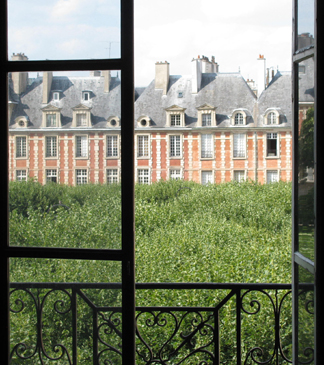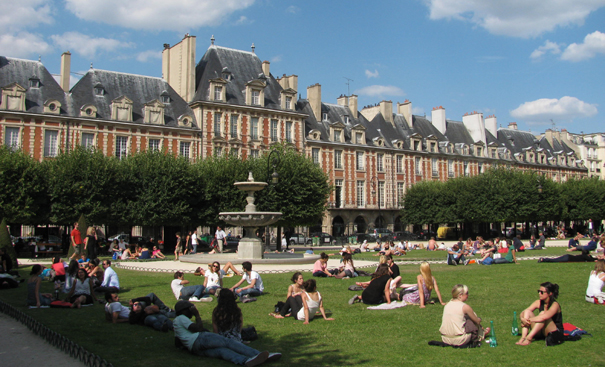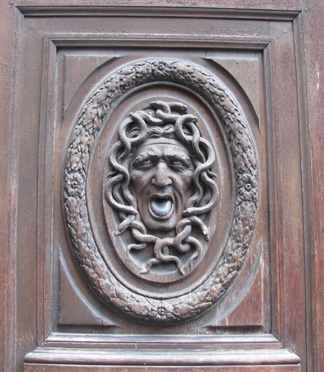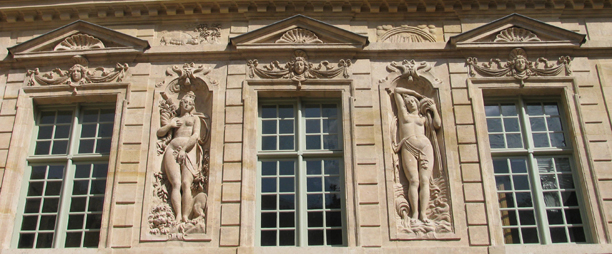
In the year 2000 I was tapped by CNN for a travel show on the “new, hottest area” in Paris—the recently regenerated neighborhoods of eastern Paris, I assumed. No, my caller had never heard of the Bastille area, and certainly not of rue Oberkampf. I was quite surprised when suddenly her memory came to her rescue and she blurted cheerily, “the M’ree”! True, the Marais was gorgeous, arty, colorful and spiced up by the vibrant gay and Jewish communities, definitely a good choice for a travel show, but in no way was it newsy.
It was in the 1960s that the rehabilitation of the Marais took off, thanks to Malraux’s Bill (La loi Malraux) initiated in 1962 by President De Gaulle’s Minister of Culture. It didn’t happen overnight and for a while property remained affordable (that was the time to buy) and courtyards wide open to outsiders (that was the time to visit). It took the Autumn Festival of classical music (alas no more) to bring the magnificent heritage of the Marais to the attention of the public and to nudge the public authorities into restoring it.
Today the Marais is a secret to no one and is saturated with day trippers and tourists on weekends and holidays. La Place des Vosges is the most expensive square in Paris, as it was right from the beginning, the city’s first open-air square — La Place Royale —, inaugurated in 1612 on the occasion of the double betrothal of Louis XIII to Anne of Austria and of their respective siblings.

Surrounded in neat order by 36 brick-and-stone townhouses, these were occupied by the most prestigious families of the nobility, among them the maternal family of Madame de Sévigné, the great letter writer who was born at no. 1. Or the Duc de Sully, the retired Minister of the murdered Henri IV, who resided on the southwest corner of the square, no. 7, now the French Heritage Trust (Caisse des Monuments Historiques), complete with an excellent bookshop. His daughter married into the great Rohan family, several members of which lived in this palace in the years that followed.
A branch of the Rohan family, married to the equally great Guénémée, resided at no. 6, on the southeastern corner of the square. It was a fabulous palace “all gilded and painted by Cotelle,” whose sketchbook of the drawings were made for this palace is now kept at the Ashmolean Library in Oxford.

The splendor was gone by the time Victor Hugo lived in this townhouse (1832 -1848), now his museum. So was the lovely garden. For after the court moved to Versailles (1682), the Parisian aristocracy shifted its centre of gravity west, causing the remote Marais to decline. The French Revolution dealt it a final blow; which is why Victor Hugo could afford to occupy an entire townhouse at this address. It is also during the French Revolution that the square was renamed after the Vosges, a thank-you gift to the newly created department (district) in eastern France for being the first to pay its taxes to the new republic.
Today Dominique Strauss-Kahn, now famous outside of France for the Sofitel chambermaid affair, and his wife Anne Sinclair reside on the Place des Vosges, in a 240 square-meter (2583 square-foot) apartment, though not a full townhouse. You would have to belong to the uppermost financial echelon to own a full-size townhouse in this kind of neighborhood, like the ruling family of Qatar for example, the new proprietors of the listed Hôtel Lambert on the eastern edge of the Ile Saint-Louis, now undergoing major restoration.
Apart from sharing this superb address in two different time zones, Victor Hugo and DSK, reports have it, also shared an insatiable sexual appetite. Victor Hugo was the most notorious fornicator of 19th-century France, resisting neither glamorous actresses nor humble chambermaids. During his time on Place des Vosges he seduced la petite boulangère from the corner bakery still standing on rue du Petit-Musc, south of rue Saint-Antoine. A back staircase in his study allowed him to repair unseen to his rendezvous by way of the Impasse Guénémée. I knew nothing about Victor Hugo’s connection to the boulangerie when I was a student round the corner in the early 1970s, and bought here occasionally my pains au chocolat and baguettes. The hotel across the street where the two of them retired was demolished in the 1950s.
DSK was thrown into jail, publicly humiliated and castigated, perhaps career-wise ruined. Victor Hugo was adulated as a national hero and honored with the biggest funeral ever held in the capital. Two million Parisians gathered along its itinerary, all the way from the Arc de Triomphe to the Panthéon.

Other members of the Rohan family lived at the magnificent no. 87 rue Vieille du Temple west of Place des Vosges, now part of the National Archives. Between 1766 and 1778 they had Caron de Beaumarchais as a neighbor, now no. 47 of the street, the Hôtel Amelot de Bisseuil, alas invisible from the street behind its splendidly carved doors that won’t yield.
The son of a watchmaker, turned arms dealer, Beaumarchais founded here the Rodriguez and Hortalez Company for the purpose of selling arms to the budding American nation in its fight against the English. He also used his time here to compose an opera and, more famously, to write a play, Le Mariage de Figaro, better known internationally in Mozart’s operatic version, a satire on the popular theme of troussage de domestique (the rolling up of a female servant’s skirts) as the journalist Jean-François Kahn (JFK) referred to the DSK affair.
Although they have the same family name, the journalist is no relation of the ex-head of the IMF, but he does happen to be a long-standing friend of his wife. This exacerbated the furor caused by his comment which sounded as though he was condoning DSK’s demeanor because it’s culturally commonplace and traditionally played down. Not so Beaumarchais who, most daringly in his play, on the eve of the French Revolution, questioned the right of a nobleman to the thighs of his female servant (le droit de cuissage), an audacity for which he was briefly jailed by order of the king.

Hailing from 21 Place Royale half a century earlier, the Duc de Richelieu and great nephew of Cardinal Richelieu bragged about his sex life with all the female residents of the square. At times the duke could be violent, notorious for experimenting with his victims on his famous armchair. The Duke went on to seduce the regent’s daughters and their cousin, but when he carried off three of regent’s mistresses, the latter had him removed from Paris by appointing him Ambassador to Vienna.
Incidentally, Mozart too stayed in the Marais, in the magnificently restored Hôtel de Beauvais, at 68 rue François Miron. The palace was built for Catherine Belier, Anne of Austria’s lady-in-waiting and better known to history as Cateau la Borgnesse (one-eyed Kate), a gift from the Queen for having initiated young Louis XIV to the facts of life! A century later seven-year-old Mozart stayed here with his father and sister Nennerl. The threesome was the guests of the Ambassador of Bavaria, Count Van Eyck, whose residence this was. Today this is the Administrative Court of Appeal which graciously keeps the courtyard open to the public. On its façade can be seen the carved heads of Cateau and of Anne of Austria. On your next visit to the Marais, don’t forget to drop by.
Thirza Vallois is the author of Around and About Paris, Romantic Paris and Aveyron, A Bridge to French Arcadia. Around and About Paris, Volume 1 is now available on Amazon as an ebook.
Thirza’s selection of businesses that enjoy the patina of time and/or are well-known landmarks:

Fine lodging, a 4-star hotel:
Hôtel Pavillon de la Reine. 28 Place des Vosges, 3rd arrondissement. Tel 01 40 29 19 19.
Fine dining, Bernard Pacaud’s 3-Michelin-starred restaurant:
L’Ambroisie. 9 Place des Vosges, 4th arrondissement. Tel. 01 42 78 51 45.
Dining with a side dish of operatic singing:
Bel Canto. 72 quai de l’Hôtel de Ville, 4th arrondissement. Tel. 01 42 78 30 18.
A favorite timeless old-time tearoom:
Le Loir dans la Théière. 3 rue des Rosiers, 4th arrondissement. Tel. 01 42 72 90 61.
Tequila, margaritas, guacamole, nachos, quesadillas, and perhaps a smattering of beautiful people:
La Perla. 26, rue François Miron, 4th arrondissement. Tel. 01 42 77 59 40.


Great article-Will be in the Marais in a couple of weeks and enjoy reading of its history.